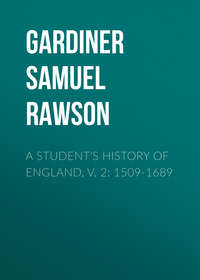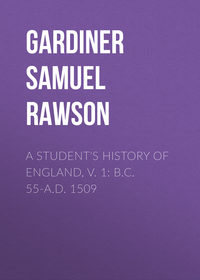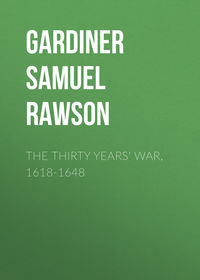 полная версия
полная версияWhat Gunpowder Plot Was
196
Father Greenway’s statement, that while the rebels were in the field, messengers came post haste continually one after the other, from the capital, all bearing proclamations mentioning Percy by name (Gerard, p. 155) is disposed of by the fact that there were only three proclamations in which Percy’s name was mentioned, dated the 5th, the 7th, and the 8th. Percy was killed on the morning of the 8th, and even the messenger who started on the 7th can hardly have known that the sheriff had gone to Holbeche, and consequently could not himself have reached that place while Percy was living.
197
See p. 11.
198
T. Winter’s examination, November 25 (G. P. B. No. 116). Compare Tresham’s declaration of November 13 (ib. No. 63).
199
Jardine’s Gunpowder Plot, p. 91.
200
Add. MSS. 11,402, fol. 109.
201
Smith’s Antiquities of Westminster, p. 41.
202
See p. 31.
203
On this, see p. 110.
204
Gerard, p. 126, note 1.
205
In an earlier part of the letter we are told of ‘Johnson,’ that ‘on Tuesday at midnight, as he was busy to prepare his things for execution was apprehended in the place itself, with a false lantern, booted and spurred.’
206
S. P. France.
207
See p. 31. I give the extract in the form received by Edmondes, that printed in Winwood, ii. 170, received by Cornwallis, being slightly different.
208
i. e. ‘owned.’
209
Gerard, p. 127.
210
Winwood, ii. 170.
211
Chamberlain to Carleton, November 7. —S. P. Dom. xvi. 23.
212
See p. 99.
213
G. P. B. No. 129.
214
Winwood, ii. 170.
215
These words look as if he had been found not in the passage but in the court.
216
He was a favourite dependent of Knyvet’s, who, on April 10, 1604, had recommended him for an office in the Tower. —S. P. Dom. vii. 18.
217
See my History of England, 1603-1642, i. 80, 81.
218
I.e. Guardians.
219
Correspondence of King James VI. with Sir Robert Cecil, pp. 31, 33, 36.
220
Correspondence of King James VI. with Sir Robert Cecil, p. 75.
221
Degli Effetti to Del Bufalo, June 16/26. —Roman Transcripts, R.O.
222
Degli Effetti to Del Bufalo, July 21/31. —Roman Transcripts, R.O.
223
See p. 142.
224
Hist. of England, 1603-1642, i. 81.
225
S. P. Scotland, lxix. 20.
226
James I. to Sir T. Parry, Nov., 1603. – Tierney’s Dodd, iv.; App. p. 66.
227
Degli Effetti to Del Bufalo, June 30/July 10 (Roman Transcripts, R.O.). There is a plain-spoken marginal note in the Pope’s hand, ‘Non sarà vero, nè noi gli habbiamo dato quest’ ordine.’ In the instructions by the Nuncio at Brussels to Dr. Gifford, July 22/August 1 (Tierney’s Dodd, iv.; App. lxvi.), nothing is said about this mission, but a definite promise is given ‘eosque omnes e regno evocare quos sua Majestas rationabiliter judicaverit regno et statui suo noxios fore.’
228
‘Salute.’ Does this mean safety or salvation, or is it left doubtful?
229
I.e. to James and to Henry IV. Del Bufalo to Cardinal Aldobrandino, July 11/21. —Roman Transcripts, R.O.
230
Del Bufalo to Cardinal Aldobrandino, July 20/30. —Roman Transcripts, R.O.
231
Barneby to Del Bufalo, Aug. 8/18. —Roman Transcripts, R.O. (The original is in Latin.)
232
Afterwards Duke of Sully.
233
Parry to Cecil, Aug. 20, 1603. —S. P. France.
234
See p. 151, note 2.
235
Del Bufalo to James I. Sept. 19/29; compare Del Bufalo to Cardinal Aldobrandino, Sept. 21/Oct. 1. —Roman Transcripts, R.O.
236
We have two copies of James’s letter to Parry translated into Latin, but undated (S. P. France.) Cecil’s covering letter (ib.) is in draft and dated Nov. 6. It must, however, have been held back, as both Parry’s and Del Bufalo’s despatches show that it did not reach Paris till early in December.
237
Del Bufalo to Cardinal Aldobrandino, December 4/14. —Roman Transcripts, R.O.
238
January 11/21.
239
Information given to Del Bufalo.
240
He wrote on the margin of Del Bufalo’s letter: “Quanto alla facoltà di chiamare sotto pena di scomunica i torbolenti, non ci par da darla per adesso, perchè trattiamo con heretici, e corriamo pericolo di perdere i sicuri, si come non ci par che il Nuntio debba premere nella cosa di mandar noi personaggio, perchè dubitiamo che essendo tanta gelosia tra Francia e Spagna non intrassimo in grandissima difficoltà. E meglio aspettare la conclusione della Pace secondo noi, perchè non sapiamo che chi mandassimo fosse per usar la prudentia necessaria.”
241
He told the Spanish Ambassador, ‘che quelli del Consiglio gli havevano fatto tanta forza che no haveva potuto far altro, ma che no si sarebbe eseguito con rigore alcuno.’ (Del Bufalo to Aldobrandino, March 27/April 6.) —Roman Transcripts, R.O.
242
Precisely the course he had recommended in his letter written to Cecil whilst he was still in Scotland, see p. 144.
243
See p. 33.
244
A news-letter gives an account of the Council meeting, from which it appears that James began by haranguing against the Puritans, but Cranborne – Cecil was now known by this title – and others asked why the Catholics were not put on the same footing, on which the King got angry, and finally directed that the Catholics should also suffer. (Advices from London, Feb. 19/March 1). —Roman Transcripts, R.O.
245
In those days liberty of conscience meant what we should call liberty of worship.
246
Lindsay at last got off to Rome in November 1604. On his proceedings there see History of England, 1603-1642, i. 224.
247
In the MS. ‘et non haverebbe.’ Mr. Rawdon Brown, amongst whose papers, now in the Record Office, this despatch is found, remarks that mistakes of this kind frequently occur in letters first ciphered and then deciphered.
248
In the margin is ‘Questo poi è troppo,’ perhaps an addition by the ambassador, or even by Mr. Rawdon Brown.
249
‘Religione’ is suggested by Mr. Rawdon Brown for the ‘ragione’ of the decipherer.
250
In the copy ‘non si può far di meno di non observar le leggi,’ the ‘non’ being incorrectly repeated.
251
“Non predicando li preti nessuna cosa più constantemente di questa che il buon Cattolico bisogna che habbia questa ferma rissolutione in se medesimo di esser per conservar la Religione pronto a solevarsi etiam contra la vita e stato del suo Principe naturale.”
252
Molin to the Doge, March 7/17, 1605, Venetian Transcripts, R.O.
253
Lindsay to James I. Jan. 26/Feb. 5, 1605, S. P. Italian States.
254
Compare the last passage quoted from Molin’s despatch, p. 161.
255
This is, however, precisely what James had failed to induce the Pope to do.
256
Father Gerard asks what ‘our offence’ was. It was clearly nothing personal to the writer, and I am strongly inclined to interpret the words as referring to Lindsay’s proceedings at Rome, of which so much had been made.
257
Sir Everard Digby to Salisbury (S. P. Dom. xvii. 10.) As Father Gerard says, the date cannot be earlier than May 4, 1605, when the Earldom was conferred on Cranborne.
258
Father Gerard gives the date of Davies’s pardon from the Pardon Roll as April 25, 1605. It should be April 23, 1604.
259
Gerard, 94, 95, 254. Father Gerard ascribes this application to ‘a later date’ than March 1606. It was, in fact a good deal later, as the endorsement ‘Mr. Secretary Conway’ shows that it was not earlier than 1623. The further endorsement ‘touching Wright and his services performed in the damnable plot of the Powder Treason,’ proves nothing. What did Conway’s clerk know beyond the contents of the application itself?
260
Father Gerard (p. 98) tells us of one Thomas Coe, who wrote on Dec. 20, 1605, telling him that he had forwarded to the King ‘the primary intelligence of these late treasons.’ If this claim was justified, why do we not find Coe’s name, either amongst the State Papers or on the Patent Rolls, as recipient of some favour from the Crown? A still more indefensible argument of Father Gerard’s is one in which a letter written to Sir Everard Digby about an otter hunt is held (p. 103) to show the existence of Government espionage, because though written before Digby was acquainted with the plot it is endorsed, ‘Letter written to Sir Everard Digby – Powder Treason.’ Any letter in Digby’s possession would be likely to be endorsed in this way whatever its contents might have been.
261
Gerard, pp. 95, 96.
262
Gerard, p. 106.
263
Salisbury to Edmondes, Oct. 17, 1605. —Stowe MSS. 168, fol. 181.
264
See History of England, 1603-1642, i. 238, 243.
265
Garnet’s Declaration, March 9, 1606. —Hist. Rev. July, 1888, p. 513.
266
Father Gerard gives a facsimile, p. 199.
267
Harl. MSS. 360, fol. 112 b.
268
See p. 128.
269
As in the case of the merchant who refused to pay the imposition on currants, ‘Bate’ and ‘Bates’ were considered interchangeable.
270
G. P. B., No. 145. The words in italics are added in a different hand. Dunbar’s name does not occur in the list of Commissioners at p. 24.
271
See p. 41.
272
Gerard, p. 179. I do not think his argument on this point conclusive, but obviously it would be useless to forge a document unless it was to be used in evidence.
273
Harl. MSS. 360, fol. 96.
274
Gerard, p. 170.
275
Salisbury’s Minute to Favat, Dec. 4, 1605. —Add. MSS. 6178, fol. 98.
276
Gerard, p. 181.
277
An alias for Garnet.
278
Salisbury to Edmondes, March 8, 1606. —Stowe MSS. 168, fol. 366.
279
Harl. MSS. 360, fol. 117.
280
Ib. fol. 113.
281
Add. MSS. 21203, fol. 38 b.
282
A true and perfect relation. Sig. G., 2, verso.
283
Ib., Sig. K., 3.
284
Morris’s Condition of Catholics, 210. A Latin translation of part of the letter was printed in 1610, by Eudæmon Joannes, Ad actionem proditoriam, &c., p. 6.
285
G. P. B., No. 166.
286
See the express words ascribed to Bates at p. 180.
287
See p. 190.
288
Sir E. Digby’s Papers, No. 9, published at the end of Bishop Barlow’s reprint of The Gunpowder Treason.
289
The Saturday or Sunday after the octave of Corpus Christi, i. e., June 8 or 9, old style, which seems to have been used, as the same day is described as being about the beginning of Trinity Term, which began on May 31.
290
Garnet’s Declaration, March 9. —Hist. Rev., July 1888 pp. 510-517.
291
The letter is printed in Tierney’s Dodd, iv. App. cix., where there is an argument in a note to show that the part from which I am about to quote came from a later letter. For my purpose the date is immaterial.
292
Garnet’s Declaration, March 9. —Hist. Rev., July 1888, pp. 510-517.
293
Garnet’s Declaration, March 10. Hist. Rev., July 1888, p. 517.
294
The author of Sir Everard Digby’s life writes: – “I fully admit that if Father Garnet was weak, his weakness was owing to an excess of kindheartedness and a loyalty to his friends that bordered on extravagance.” (The Life of a Conspirator, by ‘One of his Descendants,’ p. 134.) It will be noticed that I am inclined to go further than this.
295
In addition to what has been already said, a letter from the Nuncio at Brussels to Dr. Gifford, written on July 22/Aug. 1, 1604, may be quoted. He says that the Pope ‘paratissimum esse ea omnia pro suâ in Catholicos authoritate facere quæ Serenissimæ suæ Majestati securitatem suæ personæ, et status procurare possunt, eosque omnes e regno evocare quos sua Majestas rationabiliter judicaverit regno et statui [MS. statuti] suo noxios fore.’ —Tierney’s Dodd, App. No. 5.





